Masterpiece Story: The Dessert by John F. Francis
The Dessert by John F. Francis is a masterpiece of still-life painting. Its colorful and elaborate composition reflects 19th-century American and...
James W Singer 11 July 2025
Ten Symbols of Longevity is a landscape masterpiece of Korean art. It is a beautiful world filled with earthly perfection and cosmic energy. The scene is filled with hidden motifs and symbols that reveal an enchanting message of hope, luck, and positivity.
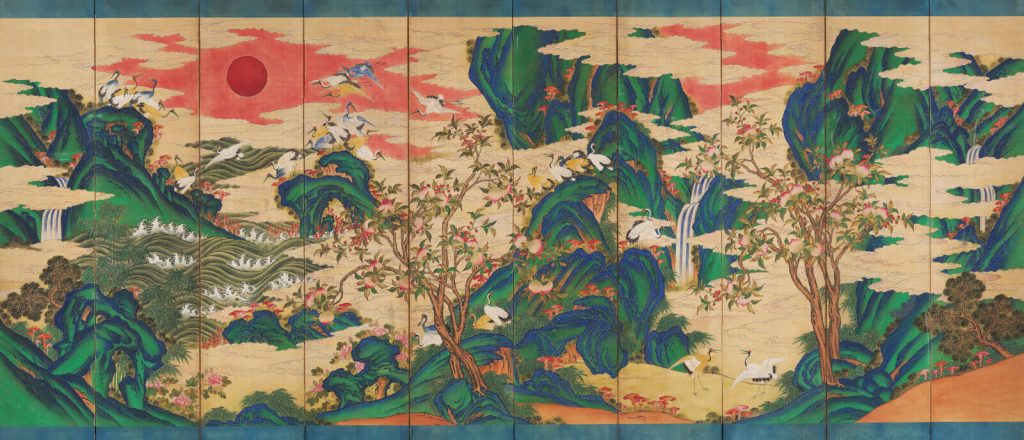
Ten Symbols of Longevity, Joseon Dynasty, ca 1866-1910, ink and color on silk, Ewha Womans University Museum, Seoul, South Korea.
Ten Symbols of Longevity was created in Korea during the Joseon Dynasty which lasted over 500 years from 1392 to 1910. The dynasty had several long periods of peace, prosperity, and cultural advancement that established some traditions and customs still practiced in modern South Korea. However, the Joseon Dynasty was sadly in political decline by the end of the 19th century. Its political downturn did not affect its artistic richness as seen in Ten Symbols of Longevity which was produced some time in the last 50 years of the dynasty. The painted silkscreen reflects the high-quality Joseon style through its large format, detailed brushstrokes, and chaesaek (brilliant colors).
The magnificent silkscreen painting is 1.66 m high and 4.16 m wide (5 ft 5 in high and 13 ft 8 in wide). It depicts a mountainous landscape filled with moving water, graceful birds, and luscious foliage. The scene is a mix between a courtly garden and an immortal world. It is therefore a mixture of earthly refinement and divine grace.
![Ten Symbols of Longevity: Kim Jeongho, Map of Hanyang [Seoul], Joseon Dynasty, ca 1840-1850, wood-block print, Library of Congress, Washington, DC, USA.](https://www.dailyartmagazine.com/wp-content/uploads/2023/01/03-Kim-Jeongho-Map-of-Hanyang-Seoul-Joseon-Dynasty-ca-1840-50-666x1024.jpg)
Kim Jeongho, Map of Hanyang [Seoul], Joseon Dynasty, ca 1840-1850, wood-block print, Library of Congress, Washington, DC, USA.
Ten Symbols of Longevity is a sipjangsaeng which is a specifically unique genre of Korean art consisting of 10 lucky or positive motifs that convey blessings upon the owner. Some motifs are based on earthly observation, such as cranes, while other motifs are based on divine imagination, such as mythical red-pink fungus. However, the majority of the motifs derive from a Chinese origin translated through a Korean lens. Interestingly, the series of motifs is viewed from right to left which is also the classically traditional direction of reading Korean script.
The painting is divided into 10 panels and each panel introduces or highlights one of the 10 auspicious motifs. Each motif conveys a nuanced attribute that collectively creates a greatly auspicious general blessing.
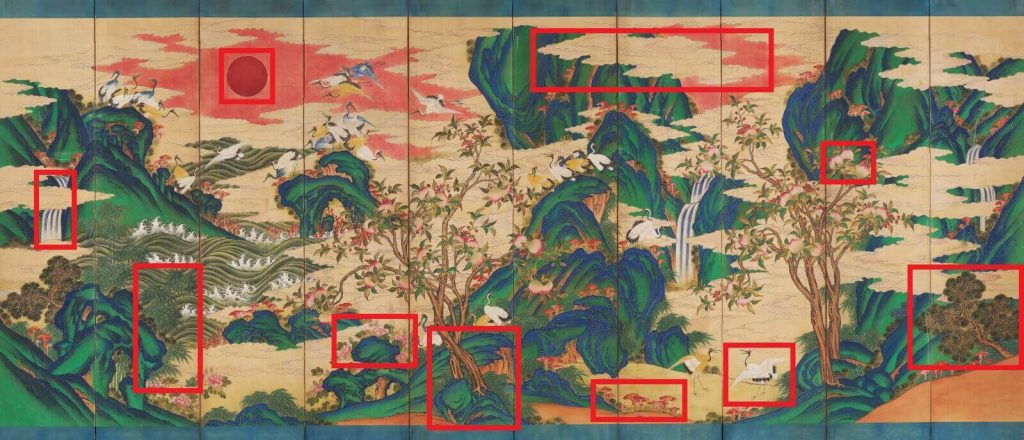
Motifs Highlighted in Ten Symbols of Longevity, 2023.
The farthest right panel begins the image’s visual reading. It features a lonely single pine tree (sonamu). It represents longevity because of its resistance to harsh winters while remaining green.
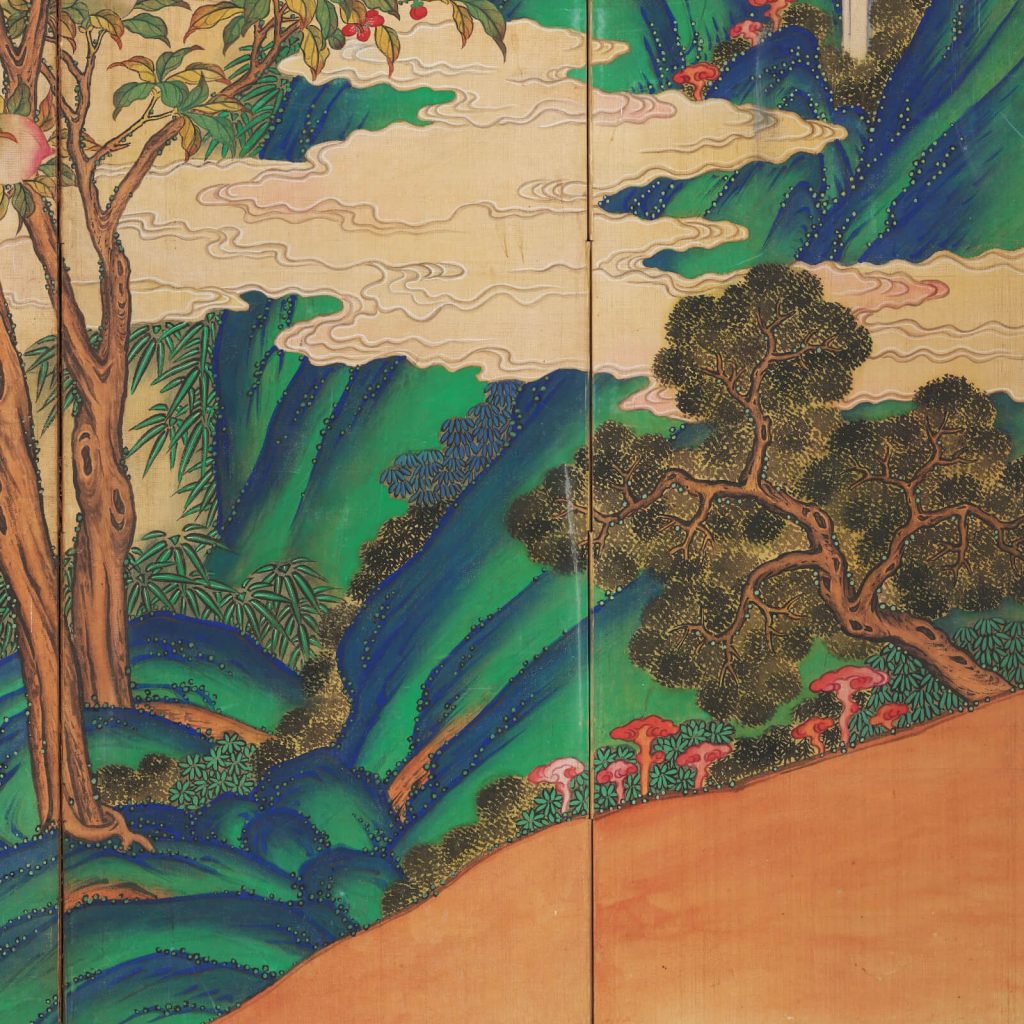
Ten Symbols of Longevity, Joseon Dynasty, ca 1866-1910, ink and color on silk, Ewha Womans University Museum, Seoul, South Korea. Detail.
The second panel presents a peach tree full of peach blossoms and peaches. The peach (bogsung-a), according to traditional Korea, resembles a woman’s breast with its full body and rouged nipple tip. It therefore is a symbol for fertility and the continuation of the family line. In traditional Korean society, producing the family’s next generation ensures your immortality as your legacy and family name can continue.

Ten Symbols of Longevity, Joseon Dynasty, ca 1866-1910, ink and color on silk, Ewha Womans University Museum, Seoul, South Korea. Detail.
The third panel has a crane (hak) fighting another crane in panel four. This first crane is one of 34 cranes within the painting. The crane is a revered bird in both Korea and China that represents wisdom, filial piety, and longevity. Cranes are one of the most popular animals depicted in Korean and Chinese paintings because of their lucky attributes and graceful poses.
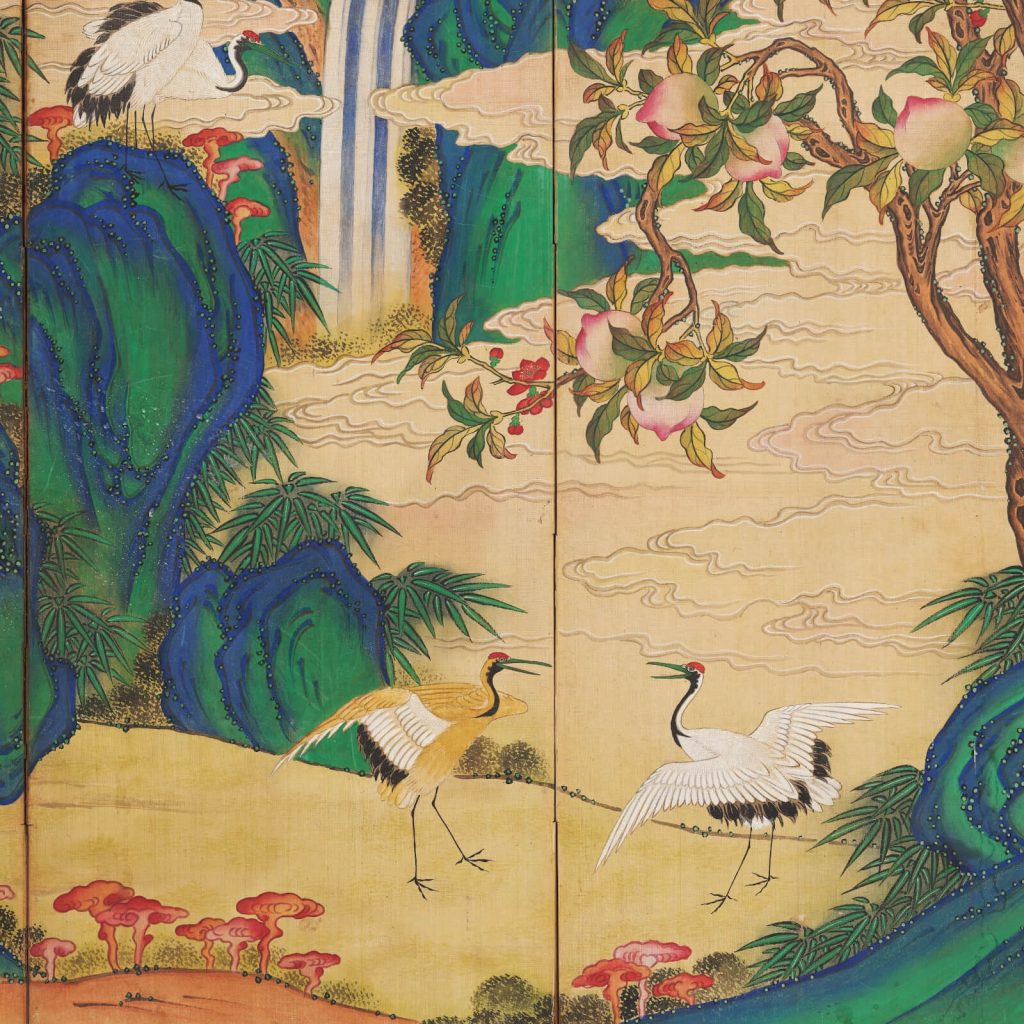
Ten Symbols of Longevity, Joseon Dynasty, ca 1866-1910, ink and color on silk, Ewha Womans University Museum, Seoul, South Korea. Detail.
Followers of Pungsu-jiri, which is a Korean geomancy similar to the Chinese feng shui, believe that groupings of similar objects can produce auspicious and inauspicious luck, and the type of luck is influenced by the number of objects. For example, the cranes in the painting are all grouped in numbers considered auspicious by pungsu-jiri and feng shui. One equals a birth or a new beginning. Two equals cooperation or balance. Three equals health, wealth, and happiness. Five equals the five elements of earth, water, metal, wood, and fire which invokes transformation or adventure. Eight equals overall prosperity. Each panel of Ten Symbols of Longevity, if it contains cranes, will have the cranes in a variation of these numbers. Therefore, the numerology of pungsu-jiri is being invoked as additional good luck in addition to the 10 symbols.
![Ten Symbols of Longevity: Donggwoldo [Painting of Eastern Palaces], Seoul, Joseon Dynasty, ca 1830, colors on silk, Seokdang Museum, Dong-A University, Busan, South Korea.](https://www.dailyartmagazine.com/wp-content/uploads/2023/01/08-Donggwoldo-Painting-of-Eastern-Palaces-Seoul-Joseon-Dynasty-ca-1830-1024x485.jpg)
Donggwoldo [Painting of Eastern Palaces], Seoul, Joseon Dynasty, ca 1830, colors on silk, Seokdang Museum, Dong-A University, Busan, South Korea.
The fourth panel has red-pink fungi (yeongji) growing in the foreground. This fungus is a Korean mythical food that allegedly contains an elixir for immortality.
The fifth panel contains a large cloud (gureum). It represents life and fertility as clouds produce rain that waters the earth. They also float and move which contains energy (chi), also a positive attribute and blessing.
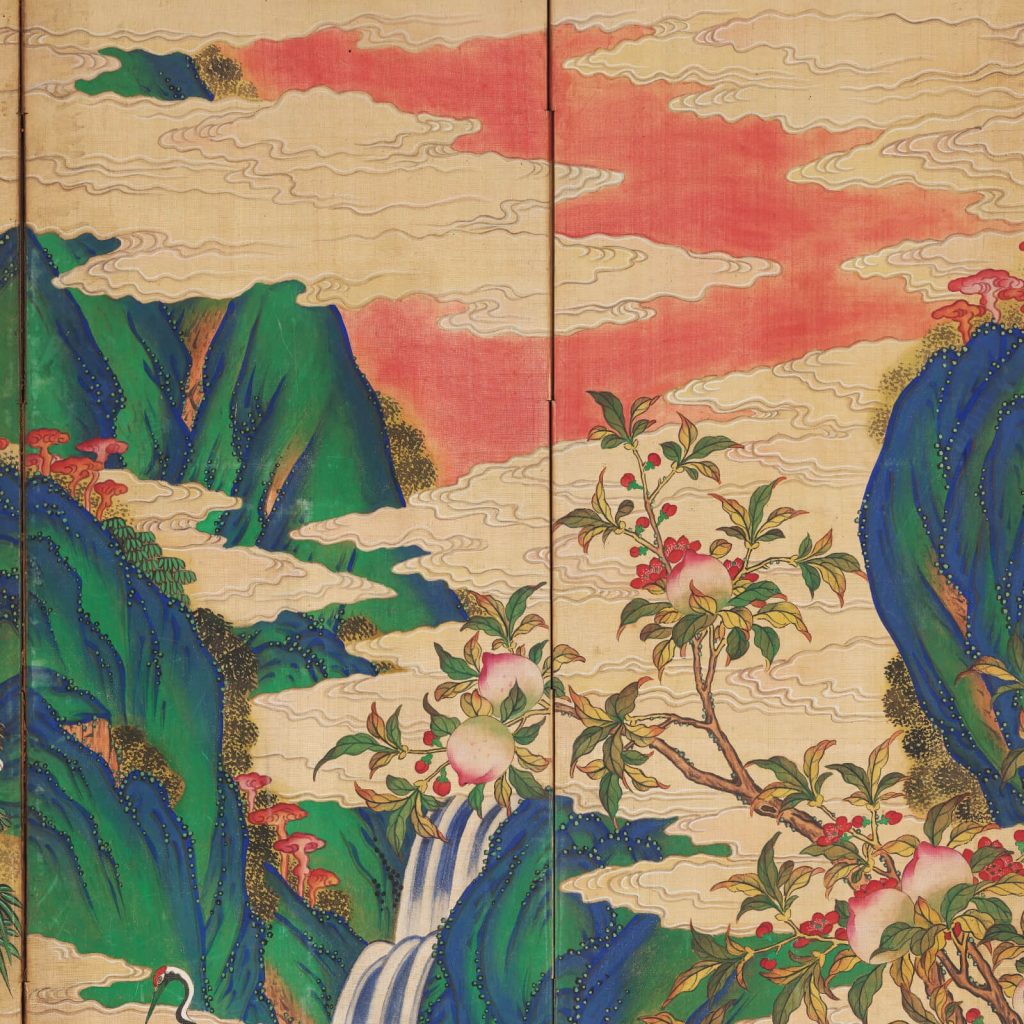
Ten Symbols of Longevity, Joseon Dynasty, ca 1866-1910, ink and color on silk, Ewha Womans University Museum, Seoul, South Korea. Detail.
The sixth panel has a mountainous terrain (san). The uneven and dramatic landscape is associated with endurance and constancy. Notice the mountains’ bold blue outlines and lustrous green interiors. The mountains feel alive with cosmic chi.
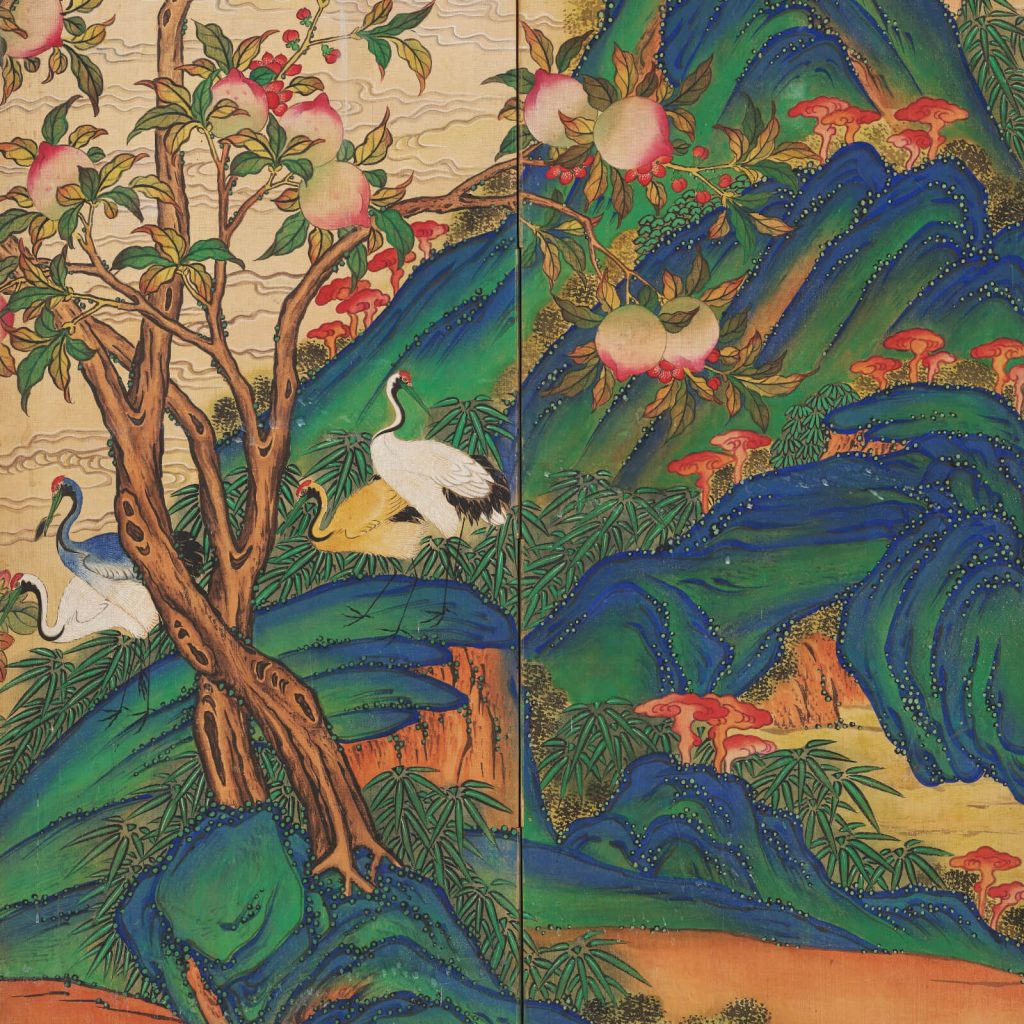
Ten Symbols of Longevity, Joseon Dynasty, ca 1866-1910, ink and color on silk, Ewha Womans University Museum, Seoul, South Korea. Detail.
The seventh panel displays some lovely pink peonies. The peony (molan) signifies female beauty and fertility. It is still today one of the most popular flowers among traditional Korean and Chinese families. Within these families, many newborn daughters are named peony in the hope that they will eventually become beautiful wives and fertile mothers.
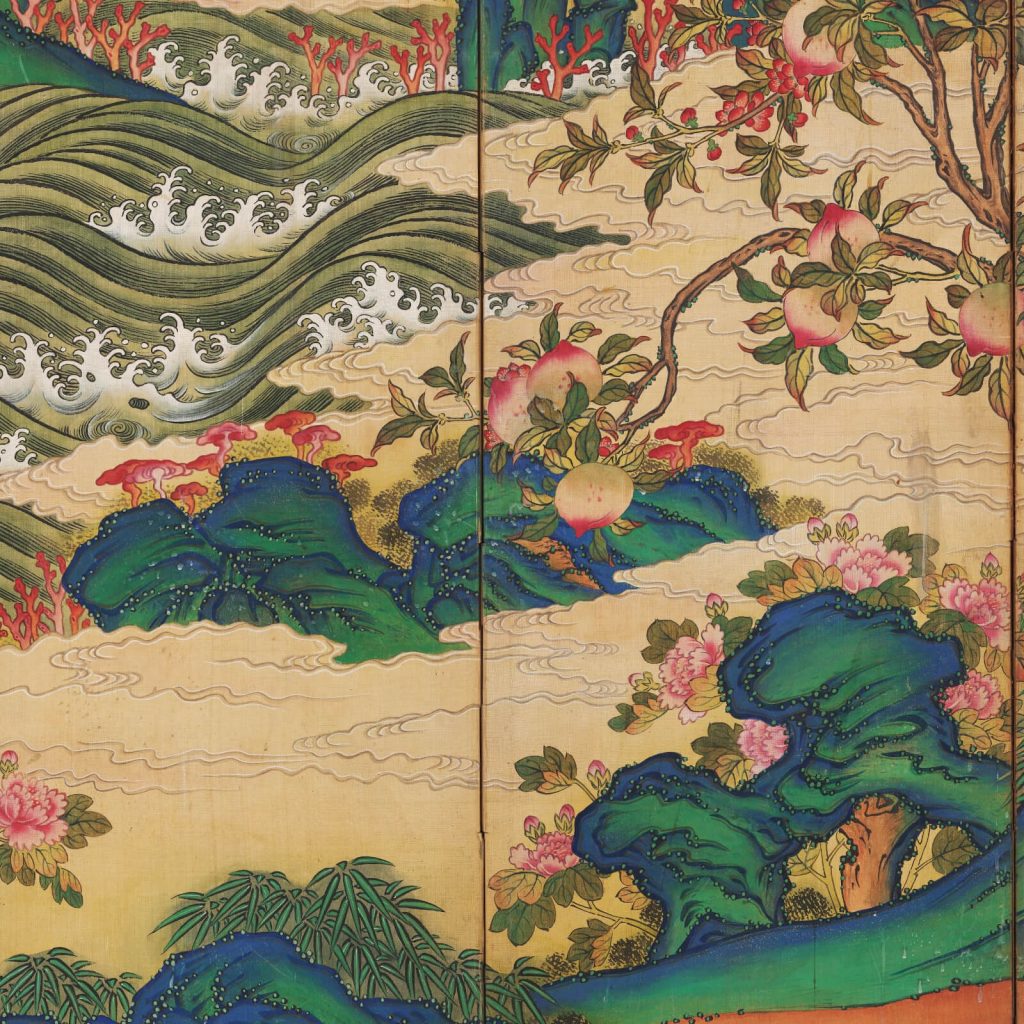
Ten Symbols of Longevity, Joseon Dynasty, ca 1866-1910, ink and color on silk, Ewha Womans University Museum, Seoul, South Korea. Detail.
The eighth panel possesses a red sun (hae). This celestial object represents warmth and regeneration. It casts sunshine onto Earth which promotes health and growth.
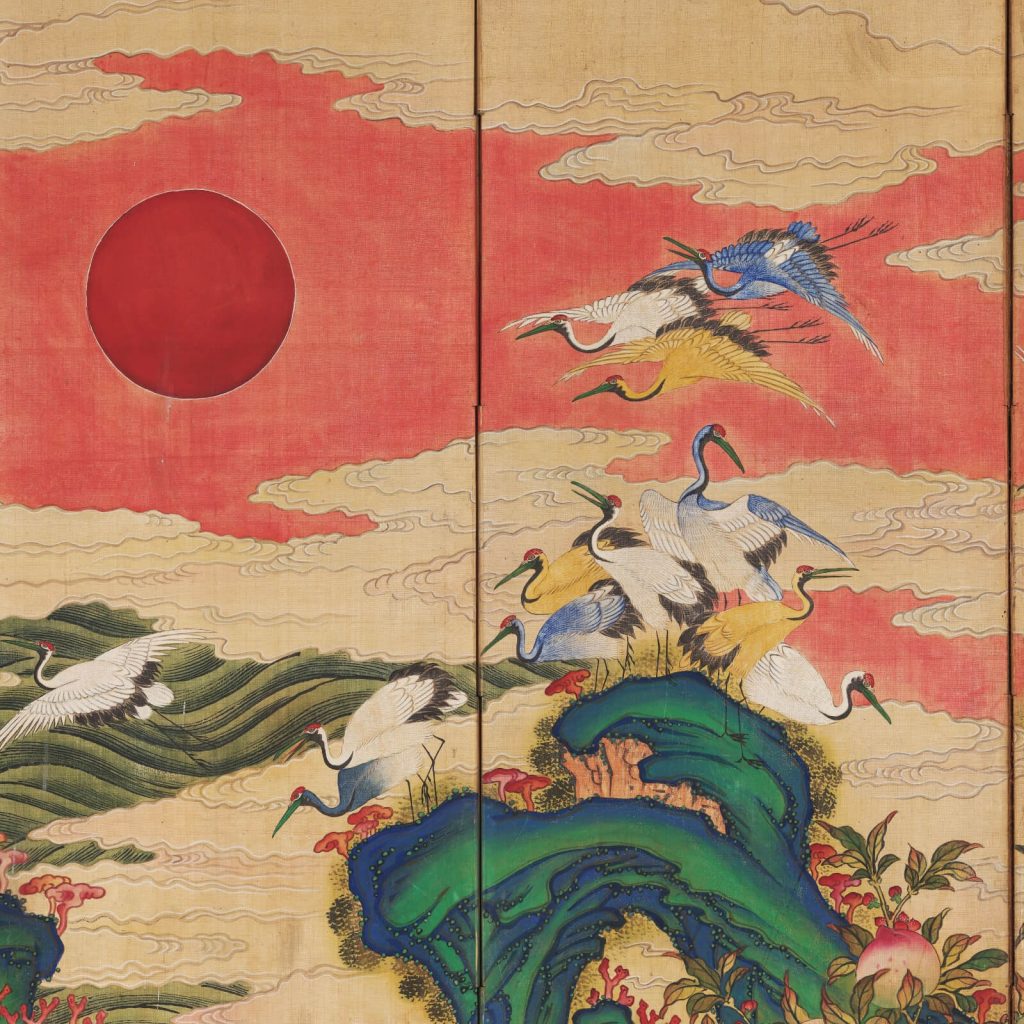
Ten Symbols of Longevity, Joseon Dynasty, ca 1866-1910, ink and color on silk, Ewha Womans University Museum, Seoul, South Korea. Detail.
The ninth panel presents bamboo (daenamu). This plant has become synonymous with Asian nations due to its expansive natural habitats. Culturally in Korea, it represents flexibility and durability.
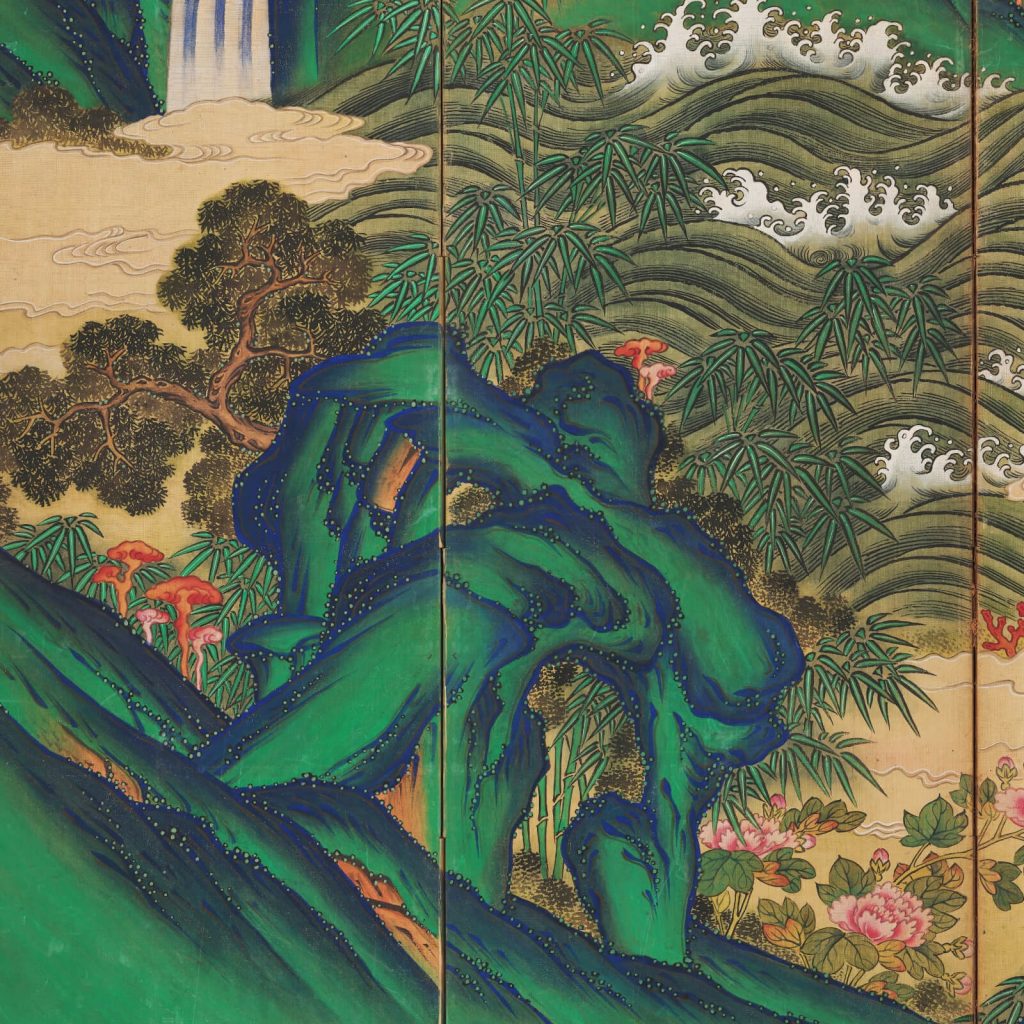
Ten Symbols of Longevity, Joseon Dynasty, ca 1866-1910, ink and color on silk, Ewha Womans University Museum, Seoul, South Korea. Detail.
The tenth and final panel on the left has flowing water (mul) down a waterfall. Like the clouds, a waterfall is life-giving and provides moisture to plants and animals. Without water, no life could exist.
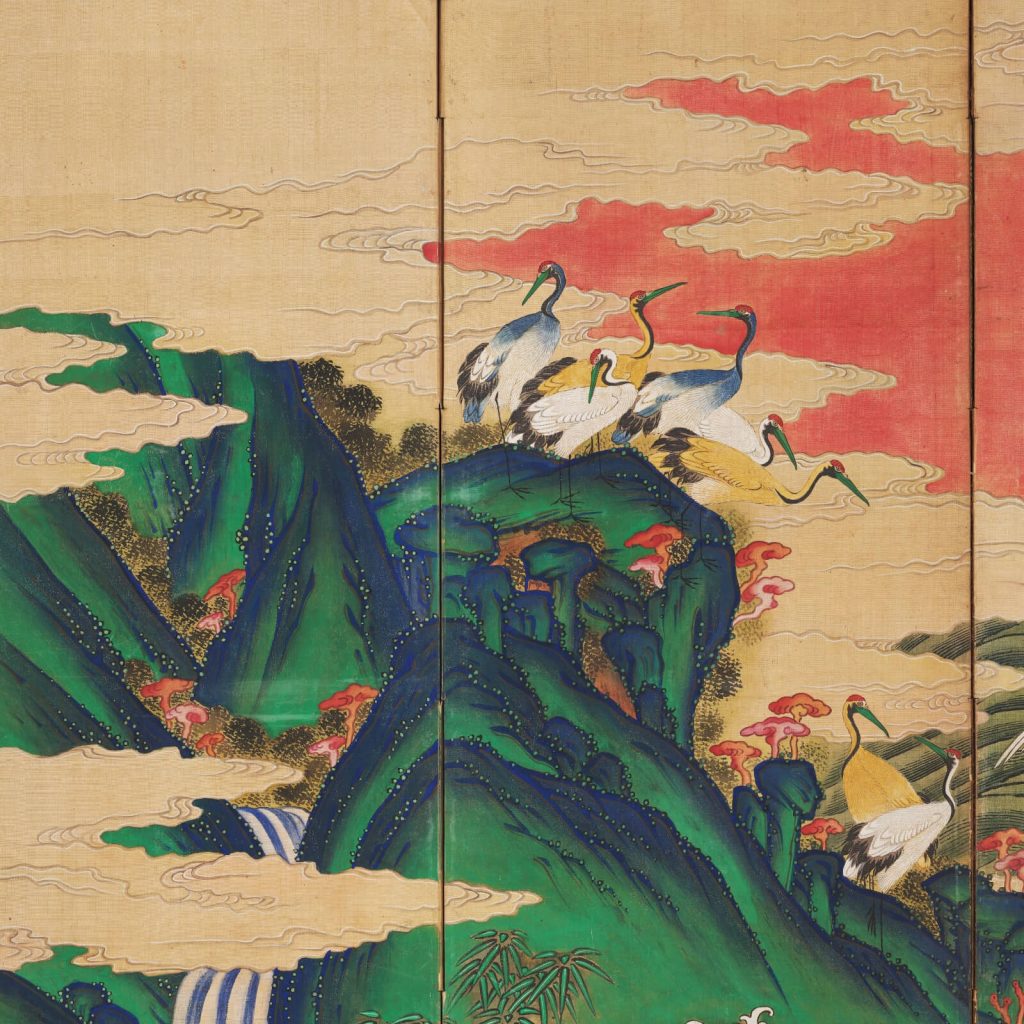
Ten Symbols of Longevity, Joseon Dynasty, ca 1866-1910, ink and color on silk, Ewha Womans University Museum, Seoul, South Korea. Detail.
Ten Symbols of Longevity is a masterpiece of Korean art filled with ornamental beauty and symbolic meaning. Its exquisite quality indicates that it was made by an artist attached to the Korean royal family. Since the piece was not found among the former royal family’s art collection, it is believed it was a gift to a valued court member or high ranking official to commemorate a special event such as a birth, a wedding, or a Lunar New Year.
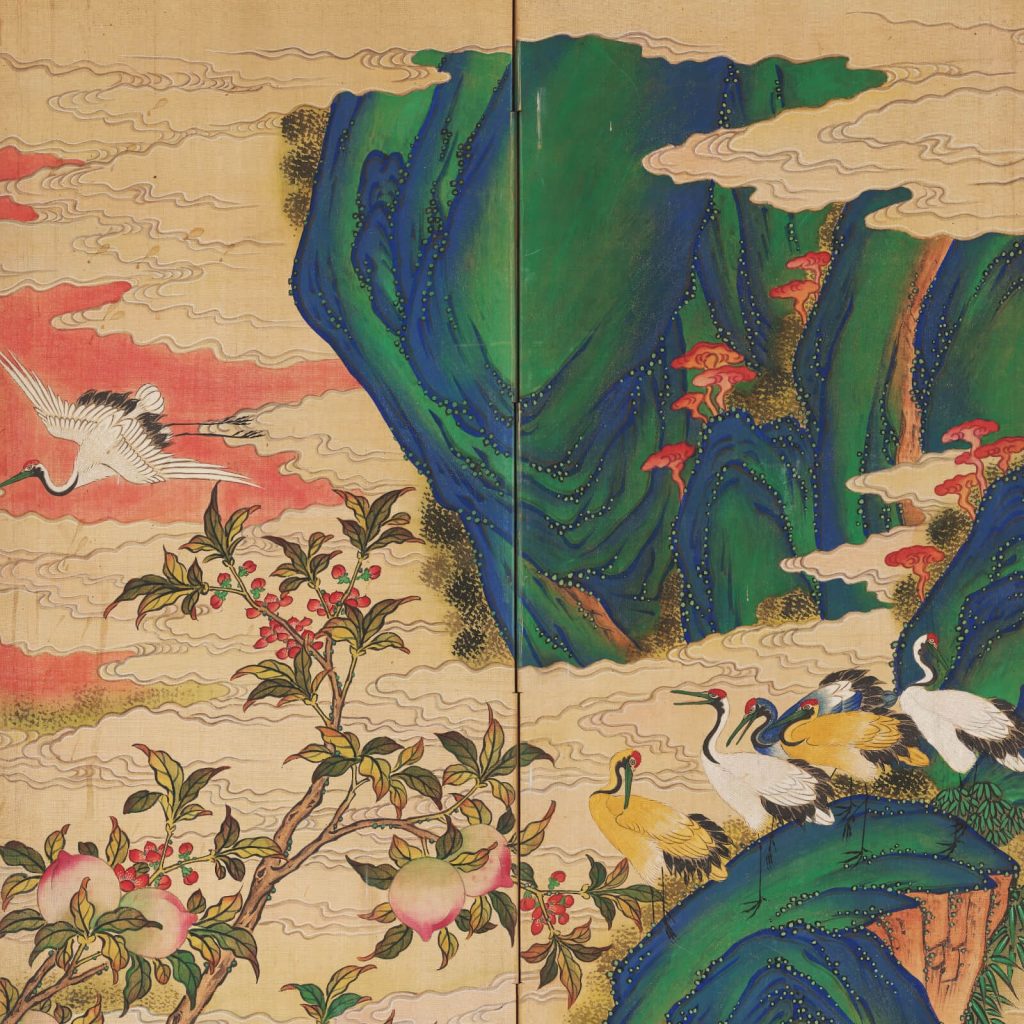
Ten Symbols of Longevity, Joseon Dynasty, ca 1866-1910, ink and color on silk, Ewha Womans University Museum, Seoul, South Korea. Detail.
It could be strongly argued that the presence of peaches and peonies within the painting implies that the original recipient was a young woman because they suggest beauty and fertility. Other silk screens of the sipjangsaeng genre do not have peaches and peonies because they instead have more masculine motifs such as deer and turtles. Hence, the inclusion of peaches and peonies is intentional, and most likely the painting was not intended for a male recipient.
Do you think the painting’s original owner was perhaps a younger unmarried sister of a Korean empress? Perhaps the original owner was a beloved concubine of a Korean emperor? Perhaps a court high-ranking official gifted the painting to his new wife? No one will probably ever know. What we do know is that Ten Symbols of Longevity invites the viewer to experience a harmonious paradise filled with luck and positivity. It summons fortune and prosperity. It evokes health, wealth, and happiness. It is a masterpiece of Korean culture.
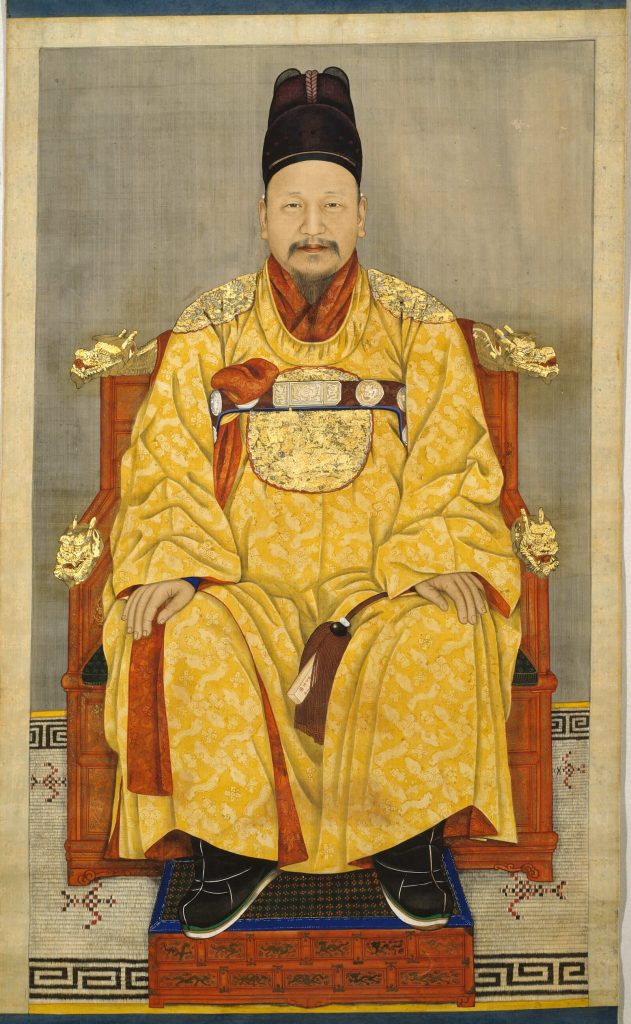
Chae Yong-sin, Emperor Gojong, ca 1897, National Museum of Korea, Seoul, South Korea.
Penny Bailey. “Korea’s Sipjangsaeng Iconography: The Quest for Longevity and Immortality in the Visual Arts of the Joseon Dynasty.” Asia-Pacific Journal vol. 18, no. 8 (April 15, 2020).
“Ten Symbols of Longevity.” Collection. Ewha Womans University Museum, Seoul, South Korea. Retrieved 12 January 2023.
DailyArt Magazine needs your support. Every contribution, however big or small, is very valuable for our future. Thanks to it, we will be able to sustain and grow the Magazine. Thank you for your help!